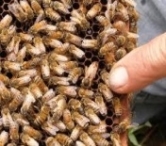The Beetle Baffle prevents the small hive beetle from moving freely within a hive
JACKSON, Miss. | There is worldwide concern about the decline in populations of honeybees that not only provide honey but pollination for many crops. Insects are responsible for pollinating about a third of the world’s crops, and honeybees do about 80 percent of that.
One major problem with the decline in bees is Colony Collapse Disorder, which has been linked to the pesticide neonicotinoid, leading to that class of pesticides being banned in the European Union.
Another serious problem is predation by the small hive beetle (SHB). The SHB larvae eat bee eggs, larval bees, pollen and honey, said Haynes Haselmaier, who has 12 beehives and about 500,000 bees on his property in Pearl River County.
The SHB eventually damage the hive so badly that the bee colony flees the hive to seek a new home.
“The beetles remain and continue to breed and lay eggs until there is nothing in the abandoned hive that represents a food source,” Haselmaier said.
“The damage frequently includes the loss of a viable bee colony as well as ruined frames and foundation on which the bees build wax comb. The comb cells are the chambers used to store pollen, honey and new bees until they complete pupation.
“Beetles lay their eggs in many places inside the hive. Sometimes some beetles join the leaving bees, so there is almost no escape from the SHB pestilence.”
Fewer bees mean fewer plants will be pollinated, and less honey will be produced. The cost of a package of replacement bees — a new queen and about 3 pounds of workers — has grown to nearly $100.
“The cost of domestic honey will increase as supply decreases,” Haselmaier said. “Many beekeepers have already chosen to do something else with their time and resources because they have lost too many hives to the beetles.
Related articles
- Bee talks in Lancashire (adoptahive.wordpress.com)
- Saving the Bees! (adoptahive.wordpress.com)












